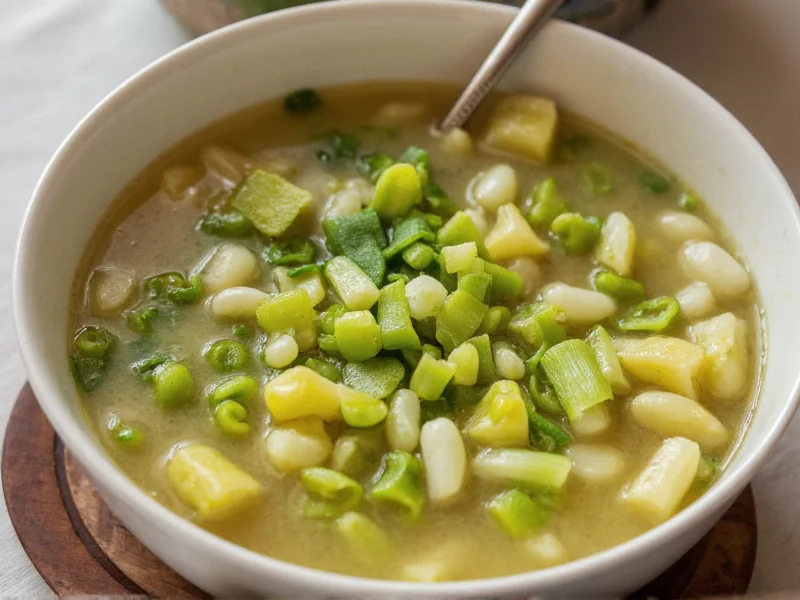When incorporating leeks into soups, understanding their unique properties transforms ordinary broths into culinary masterpieces. Unlike onions, leeks offer a milder, more nuanced flavor profile that complements rather than dominates. This makes them ideal for delicate consommés, creamy bisques, and hearty vegetable soups where balance is essential.
The Anatomy of Leek Perfection in Soup
Leeks consist of distinct sections that behave differently during cooking. The white and pale green portions contain more sugar, creating sweetness when caramelized, while the darker green sections offer grassier notes better suited for stock preparation. Many home cooks make the critical error of discarding too much of the green portion—up to two inches of usable, flavorful material often gets wasted.
Mastering Leek Preparation Techniques
Proper cleaning remains the most crucial step in how to clean leeks for soup. Cut off roots and dark green tops, then slice lengthwise through the white base. Submerge in cold water, separating layers to release trapped soil. Swirl gently and lift leeks out—never pour, as this returns dirt to cleaned vegetables. For best way to slice leeks for soup, use a sharp knife to create uniform ¼-inch half-moons that cook evenly.
| Leek Section | Texture When Cooked | Optimal Cooking Time | Best Soup Applications |
|---|---|---|---|
| White base | Creamy, tender | 20-25 minutes | Cream soups, delicate broths |
| Light green | Firm yet yielding | 15-20 minutes | Vegetable soups, chowders |
| Dark green | Fibrous, herbal | 45+ minutes | Stocks, hearty stews |
Timing Your Leek Integration
The question of when to add leeks to soup determines final texture and flavor intensity. For subtle background notes, add sliced leeks during the initial sauté with aromatics. For pronounced leek flavor, incorporate them midway through cooking. The white part of leek vs green part in soup requires different timing—white sections need longer cooking to mellow their sharper notes, while green portions can be added later to preserve their fresh character.
Flavor Pairing Strategies
Leeks harmonize beautifully with specific ingredients to create signature soup profiles. Pair with potatoes and celery for classic vichyssoise, combine with bacon and thyme for rustic French flavors, or blend with mushrooms for earthy depth. When developing leek soup recipe variations, consider acid components like lemon juice or vinegar to balance their natural sweetness. For dairy-based soups, add cream after cooking to prevent curdling.
Avoiding Common Leek Mistakes
Many cooks commit critical errors that compromise soup quality. Overcooking transforms leeks into mushy fragments rather than maintaining distinct texture. Insufficient cleaning leaves gritty particles that ruin mouthfeel. Using only the white portion wastes valuable flavor potential from the green sections. For those seeking substitutes for leeks in soup, shallots provide closest flavor but require reduced quantity due to stronger taste.
Nutritional Enhancement Through Proper Technique
Beyond flavor, understanding nutritional benefits of leeks in soup reveals why they're worth the preparation effort. They're rich in vitamins K (essential for blood health) and A (supports vision), plus contain prebiotic fibers that nourish gut bacteria. To maximize nutrient retention, avoid boiling vigorously—simmer gently after the initial sauté. The fat content in cream-based soups actually enhances absorption of fat-soluble vitamins present in leeks.
Advanced Applications for Culinary Excellence
Professional chefs employ specialized techniques for cooking time for leeks in soup perfection. Try the 'sweat and sweat again' method: sauté leeks until translucent, remove from pot, then return them during the final 10 minutes of cooking to maintain distinct texture. For restaurant-quality presentation, reserve some thinly sliced raw leeks to garnish finished soup. When making pureed soups, pass cooked leeks through a fine-mesh sieve to eliminate any fibrous remnants.
Seasonal Considerations
Spring leeks offer the most delicate flavor with minimal fibrousness, while fall varieties provide more robust taste that stands up to heartier ingredients. During winter months, look for 'second crop' leeks that have developed sweeter notes from cold exposure. Understanding these seasonal variations helps determine appropriate leek to soup ratio—use more in summer for subtle flavor, less in winter when their taste is more pronounced.
Conclusion
Mastering leek integration elevates soup from simple sustenance to culinary art. By respecting their unique structure, flavor profile, and cooking requirements, you transform this humble vegetable into soup's secret weapon. Whether crafting a delicate consommé or robust chowder, proper leek preparation creates dimensional flavor and texture that defines exceptional soups. The extra attention to cleaning, slicing, and timing pays exponential dividends in final dish quality—proving that sometimes, the simplest ingredients yield the most profound results.











 浙公网安备
33010002000092号
浙公网安备
33010002000092号 浙B2-20120091-4
浙B2-20120091-4